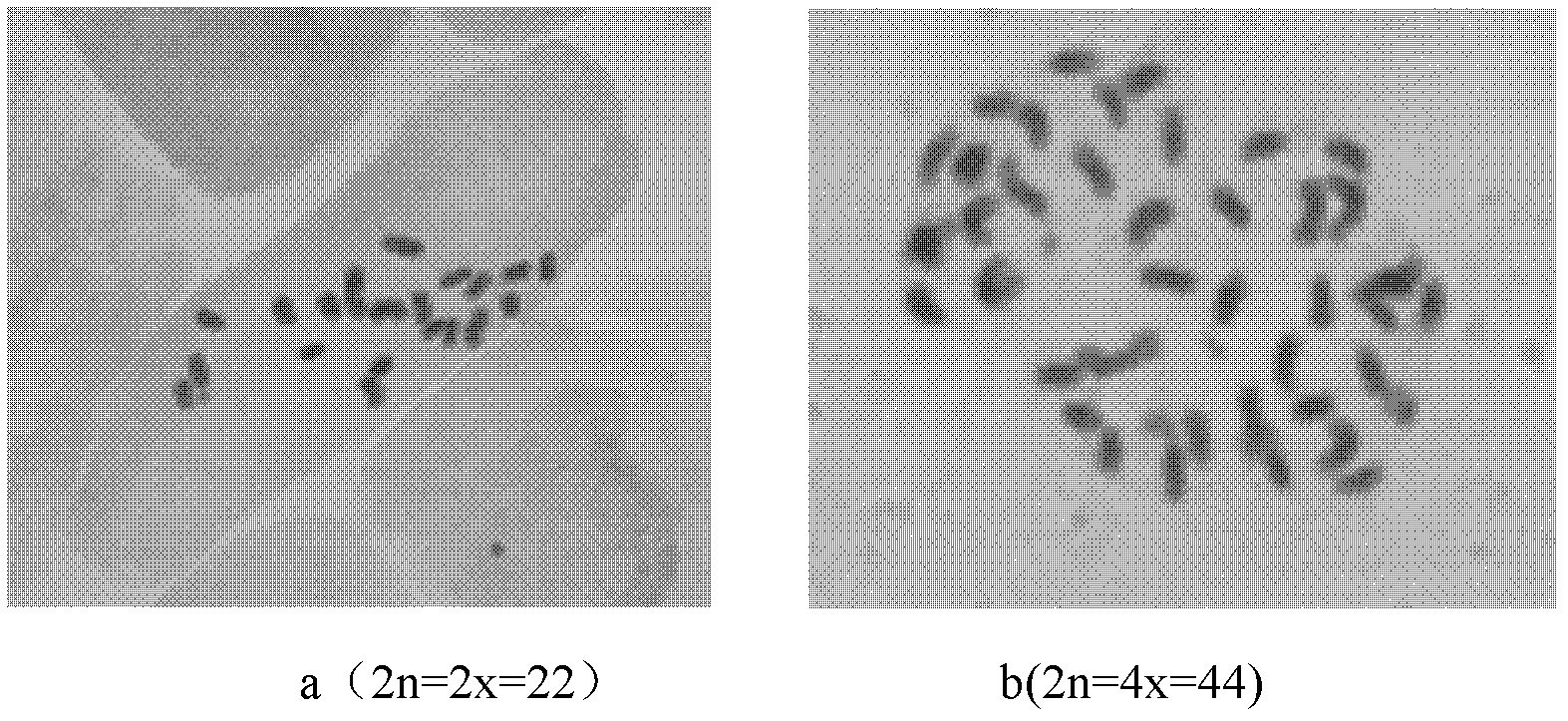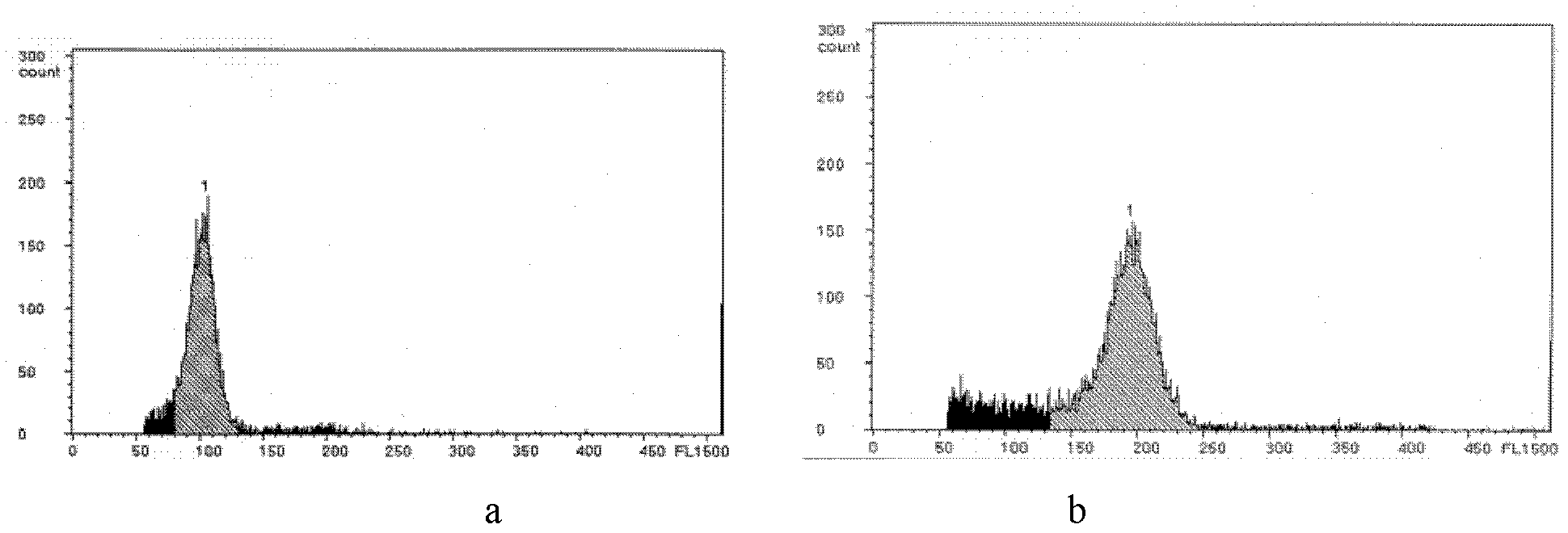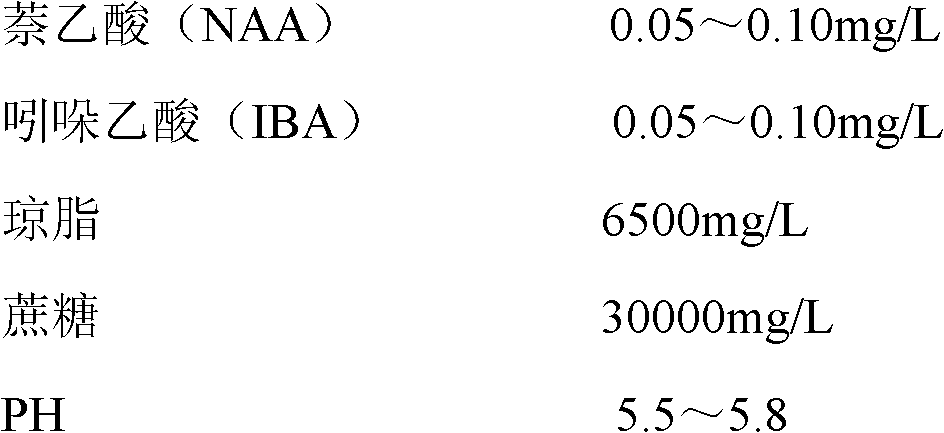Method for cultivating autotetraploid plants of stevia rebaudiana
A technology of autotetraploid and breeding method, which is applied in the cultivation of new plant varieties and the cultivation of sugar crop stevia autotetraploid plants, can solve the problem of low steviol glycoside content, achieve short internodes, Improve work efficiency, the effect of deep leaf color
- Summary
- Abstract
- Description
- Claims
- Application Information
AI Technical Summary
Problems solved by technology
Method used
Image
Examples
Embodiment 1
[0049] (1) Acquisition of adventitious buds: select the robust tender shoots of stevia plants, wash them with washing powder first, then rinse them with flowing water for 2 hours, soak them in 75% alcohol for 30 seconds, rinse them with sterile water for 2 to 3 times, and then put them in 0.10 % mercuric chloride solution for 5 minutes, rinsed with sterile water for 3 to 4 times, and inoculated the sterilized shoots into the following induction medium:
[0050] MS medium
[0051]
[0052] The cultivation room uses fluorescent lamps as the light source, the illuminance is 1500Lx, the illumination is 12h per day, and the temperature is (24±1)°C for 20 days to induce a large number of adventitious buds.
[0053] (2) Stevia autotetraploid induction: soak the adventitious buds in a 0.5g / L colchicine solution (adding 2% dimethyl sulfoxide) for 12-48 hours, soak 30 buds for each treatment Adventitious buds. After soaking, the adventitious buds were rinsed with sterile water for ...
Embodiment 2
[0063] (1) Acquisition of adventitious buds: select healthy young buds of Stevia rebaudiana plants, wash them with washing powder and then rinse them with flowing water for 1.5 hours. Soak in 75% alcohol for 30 seconds, rinse with sterile water for 2 to 3 times, then soak in 0.10% mercuric chloride solution for 6 minutes, and rinse with sterile water for 3 to 4 times. Inoculate the sterilized stem segments into induction medium: MS medium + 0.2mg / L6-BA + 0.1mg / L KT + 0.01mg / LNAA + 6500mg / L agar + 30000mg / L sucrose, pH 5.6. The cultivation room uses fluorescent lamps as the light source, the illuminance is 1500-2000Lx, the light is 12h per day, and the temperature is (24±1)°C for 15 days to induce a large number of adventitious buds.
[0064] (2) Stevia autotetraploid induction: soak the adventitious buds in a colchicine solution with a concentration of 1.0 g / L (adding 2% dimethyl sulfoxide) for 12 to 48 hours, soaking 30 buds for each treatment Adventitious buds. After soaki...
Embodiment 3
[0070] (1) Acquisition of adventitious buds: select robust young buds of stevia plants, wash them with washing powder and then rinse them with running water for 1-2 hours. Soak in 75% alcohol for 30 seconds, rinse with sterile water for 2 to 3 times, then soak in 0.10% mercury chloride solution for 5 minutes, and rinse with sterile water for 3 to 4 times. Inoculate the sterilized stem segment into the following induction medium: MS medium + 0.3mg / L6-BA + 0.2mg / L KT + 0.05mg / LNAA + 6500mg / L agar + 30000mg / L sucrose, pH 5.8 induction variable bud. The cultivation room uses fluorescent lamps as the light source, the illuminance is 1500-2000Lx, the light is 12h per day, and the temperature is (24±1)°C for 20 days to induce a large number of adventitious buds.
[0071] (2) Stevia autotetraploid induction: soak the adventitious buds in a 2.0 g / L colchicine solution (adding 2% dimethyl sulfoxide) for 12 to 48 hours, soaking 30 buds for each treatment Adventitious buds. After soaki...
PUM
 Login to View More
Login to View More Abstract
Description
Claims
Application Information
 Login to View More
Login to View More - R&D
- Intellectual Property
- Life Sciences
- Materials
- Tech Scout
- Unparalleled Data Quality
- Higher Quality Content
- 60% Fewer Hallucinations
Browse by: Latest US Patents, China's latest patents, Technical Efficacy Thesaurus, Application Domain, Technology Topic, Popular Technical Reports.
© 2025 PatSnap. All rights reserved.Legal|Privacy policy|Modern Slavery Act Transparency Statement|Sitemap|About US| Contact US: help@patsnap.com



